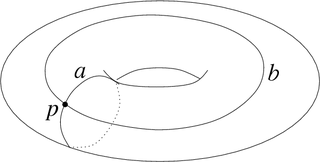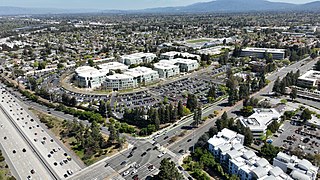A cosmological argument, in natural theology, is an argument which claims that the existence of God can be inferred from facts concerning causation, explanation, change, motion, contingency, dependency, or finitude with respect to the universe or some totality of objects. A cosmological argument can also sometimes be referred to as an argument from universal causation, an argument from first cause, the causal argument, or prime mover argument. Whichever term is employed, there are two basic variants of the argument, each with subtle yet important distinctions: in esse (essentiality), and in fieri (becoming).
In computer programming, an infinite loop is a sequence of instructions that, as written, will continue endlessly, unless an external intervention occurs, such as turning off power via a switch or pulling a plug. It may be intentional.
In computer science, control flow is the order in which individual statements, instructions or function calls of an imperative program are executed or evaluated. The emphasis on explicit control flow distinguishes an imperative programming language from a declarative programming language.

The Big Crunch is a hypothetical scenario for the ultimate fate of the universe, in which the expansion of the universe eventually reverses and the universe recollapses, ultimately causing the cosmic scale factor to reach zero, an event potentially followed by a reformation of the universe starting with another Big Bang. The vast majority of evidence indicates that this hypothesis is not correct. Instead, astronomical observations show that the expansion of the universe is accelerating rather than being slowed by gravity, suggesting that a Big Chill is more likely. However, there are new theories that suggest that a "Big Crunch-style" event could happen by the way of a dark energy fluctuation; however, this is still being debated amongst scientists.

Renormalization is a collection of techniques in quantum field theory, statistical field theory, and the theory of self-similar geometric structures, that are used to treat infinities arising in calculated quantities by altering values of these quantities to compensate for effects of their self-interactions. But even if no infinities arose in loop diagrams in quantum field theory, it could be shown that it would be necessary to renormalize the mass and fields appearing in the original Lagrangian.

In discrete mathematics, and more specifically in graph theory, a graph is a structure amounting to a set of objects in which some pairs of the objects are in some sense "related". The objects correspond to mathematical abstractions called vertices and each of the related pairs of vertices is called an edge. Typically, a graph is depicted in diagrammatic form as a set of dots or circles for the vertices, joined by lines or curves for the edges. Graphs are one of the objects of study in discrete mathematics.
109 is the natural number following 108 and preceding 110.

In the mathematical field of graph theory, a spanning treeT of an undirected graph G is a subgraph that is a tree which includes all of the vertices of G. In general, a graph may have several spanning trees, but a graph that is not connected will not contain a spanning tree. If all of the edges of G are also edges of a spanning tree T of G, then G is a tree and is identical to T.

In computer programming, foreach loop is a control flow statement for traversing items in a collection. foreach is usually used in place of a standard for loop statement. Unlike other for loop constructs, however, foreach loops usually maintain no explicit counter: they essentially say "do this to everything in this set", rather than "do this x times". This avoids potential off-by-one errors and makes code simpler to read. In object-oriented languages, an iterator, even if implicit, is often used as the means of traversal.

In mathematics, a loop in a topological space X is a continuous function f from the unit interval I = [0,1] to X such that f(0) = f(1). In other words, it is a path whose initial point is equal to its terminal point.
In mathematics and computer science, Zeno machines are a hypothetical computational model related to Turing machines that are capable of carrying out computations involving a countably infinite number of algorithmic steps. These machines are ruled out in most models of computation.
In mathematics, loop algebras are certain types of Lie algebras, of particular interest in theoretical physics.
The open-loop gain of an electronic amplifier is the gain obtained when no overall feedback is used in the circuit.
In mathematics, a Hilbert manifold is a manifold modeled on Hilbert spaces. Thus it is a separable Hausdorff space in which each point has a neighbourhood homeomorphic to an infinite dimensional Hilbert space. The concept of a Hilbert manifold provides a possibility of extending the theory of manifolds to infinite-dimensional setting. Analogous to the finite-dimensional situation, one can define a differentiable Hilbert manifold by considering a maximal atlas in which the transition maps are differentiable.
T2 Temporal Prover is an automated program analyzer developed in the Terminator research project at Microsoft Research.

Infinity is something which is boundless, endless, or larger than any natural number. It is often denoted by the infinity symbol .

In knot theory, a branch of mathematics, a twist knot is a knot obtained by repeatedly twisting a closed loop and then linking the ends together. The twist knots are an infinite family of knots, and are considered the simplest type of knots after the torus knots.

The Apple Campus is the former corporate headquarters of Apple Inc. from 1993 until 2017. In April 2017, it was largely replaced by Apple Park, but is still an Apple office and lab space. The campus is located at 1 Infinite Loop in Cupertino, California, United States. Its design resembles that of a university, with the buildings arranged around green spaces.
In topology, a branch of mathematics, given a topological monoid X up to homotopy, an infinite loop space machine produces a group completion of X together with infinite loop space structure. For example, one can take X to be the classifying space of a symmetric monoidal category S; that is, . Then the machine produces the group completion . The space may be described by the K-theory spectrum of S.
In quantum field theory, the Polyakov loop is the thermal analogue of the Wilson loop, acting as an order parameter for confinement in pure gauge theories at nonzero temperatures. In particular, it is a Wilson loop that winds around the compactified Euclidean temporal direction of a thermal quantum field theory. It indicates confinement because its vacuum expectation value must vanish in the confined phase due to its non-invariance under center gauge transformations. This also follows from the fact that the expectation value is related to the free energy of individual quarks, which diverges in this phase. Introduced by Alexander M. Polyakov in 1975, they can also be used to study the potential between pairs of quarks at nonzero temperatures.









